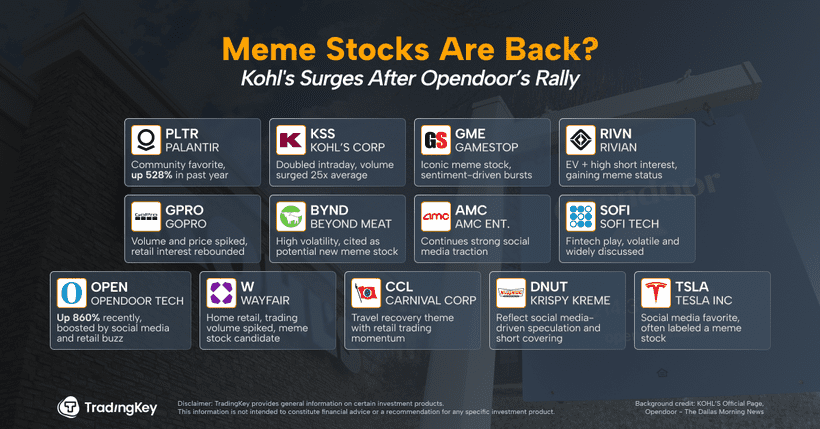TradingKey - The meme stock craze is back—and this time, it's spilling over into a broader range of beaten-down, highly speculative names.
It all started with Opendoor Technologies Inc. (OPEN), which suddenly caught fire on social media last week. Soon after, retail traders began piling into other names like Kohl’s Corp. (KSS), GoPro Inc. (GPRO), and Krispy Kreme Inc. (DNUT)—stocks that had been largely written off by Wall Street.
What happened?
Opendoor was trading below $1 just a week ago. But after a popular hedge fund manager, Eric Jackson of EMJ Capital, posted on X that he'd taken a position in the stock on July 14, it took off. Shares have now rallied six sessions in a row—each with double-digit gains—and are up a staggering 439% in a month.

By Tuesday, meme stock mania shifted gears. The new target: Kohl’s. The department store chain has been struggling amid e-commerce competition, and nearly half of its floating shares were sold short as of Monday, according to FactSet—meaning institutional investors were heavily betting against it.
That made it perfect fuel for a retail rally. As of Tuesday morning, Kohl’s shares had more than doubled. Just a week prior, it was hovering around $9. The sudden spike attracted a swarm of attention from Reddit, X, and TikTok communities.
The enthusiasm spilled over on Wednesday, with GoPro shooting up 57% and Krispy Kreme rallying 20%—despite no big news to justify the moves. Meanwhile, earlier meme darlings started to slide: Opendoor dropped 19% and Kohl’s fell 13%, highlighting the rollercoaster volatility that’s become a defining feature of this space.
What’s driving these rallies?
Kohl’s jaw-dropping 105% intraday rally on Tuesday didn’t come on the back of strong earnings or business news. Instead, traders point to a familiar technical pattern known as a 「gamma squeeze」 as the main driver behind the surge.
It all began with the stock’s unusually high short interest—nearly 49% of its float had been sold short, according to FactSet. In such cases, even a small upward move can trigger a wave of short-covering from bearish investors trying to limit their losses, fueling what’s known as a 「short squeeze.」
But that was just the starting point. As the stock picked up momentum, retail traders and momentum chasers piled into at-the-money call options—those tied to strike prices close to the trading price. When this happens, market makers who sell those options need to hedge their risk by buying the underlying stock, which adds even more upward pressure on the price.
Once the move catches fire on social media, it spreads fast. Retail investors jump in driven by hype, price charts, and a fear of missing out. The feedback loop intensifies: option demand leads to more stock buying, which leads to more price action, and the cycle continues. That’s the essence of a gamma squeeze—and exactly what we’ve seen before in GameStop and other meme stock rallies.
Why now? What’s sparked the comeback?
This resurgence comes at a moment of peak optimism in markets. The S&P 500 is sitting at all-time highs. Bitcoin has more than doubled in the past year. SPACs are back in fashion.
Put simply, investor risk appetite is rising.
Adding fuel to the fire: This year's earlier market panic, triggered by Trump’s proposed tariffs, was short-lived. After he paused those measures, we saw one of the fastest bear market recoveries on record—what some traders have dubbed the 「TACO trade」 (Trump Announced, Canceled Order). That fast rebound seems to have rekindled confidence among retail traders, who are increasingly emboldened to jump into high-risk plays.
Signs of a possible bubble?
Some analysts are waving warning flags. Barclays derivatives strategists Stefano Pascale and Anshul Gupta, for example, say the mood is getting frothy. Since early July, they’ve noted tell-tale bubble signals: a surge in SPAC activity and a 73% three-month rally in Cathie Wood’s ARK Innovation ETF—a retail favorite stacked with high-beta tech names.
Meanwhile, investor sentiment indicators like the 「Fear & Greed Index」 suggest that individual investors remain heavily tilted toward the 「greed」 side—even with stocks near record highs.

Meme stock names to watch
Multiple meme stock indexes now track retail-driven trades, including the Solactive Roundhill Meme Stock Index. But even these struggle to keep up with the fast-paced shifts in this noisy market.

As of now, some of the hottest meme tickers include:
- Opendoor Technologies (OPEN)
- Kohl’s Corp (KSS)
- GoPro (GPRO)
- Krispy Kreme (DNUT)
- Beyond Meat (BYND)
- Tesla (TSLA)
- Palantir Technologies (PLTR)
- GameStop (GME)
- AMC Entertainment (AMC)
- SoFi Technologies (SOFI)
- Rivian Automotive (RIVN)
- Carnival Corp. (CCL)
- Wayfair (WAYFAIR)

Get Started Now
Find out more